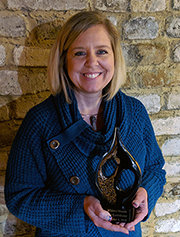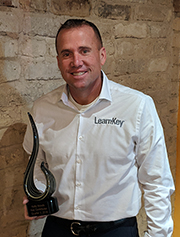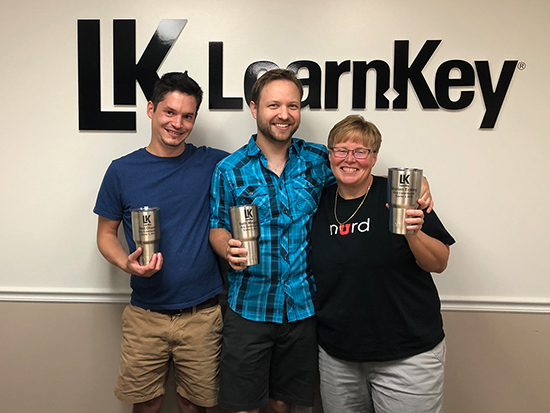
Category: Just For Fun
In Sheena We Trust!
Our newest Key Contributor Award winner is Sheena Chamberlain and in Sheena we trust.
This year LearnKey is rolling out new technology and tools so our learners have the best learning experience. The first roll out was enhancements to our student information system (SIS 2.0) in February this year. That was no easy task, however, having lots of expertise in-house that project was more manageable.
Our new Learning Management System has been a huge undertaking and in development for well over a year. This is new state of the art technology that has yet to be rolled out enterprise wide.
In January 2019 we realized we needed an A+ team player to begin to manage the beta testing and early adoption of this new system. In a perfect world someone would have come on board and had several months to get up to speed by working with the developers, our in house designers and production team. That did not happen.
What happened was Sheena Chamberlain stepped up an said “I can do this” without any hesitation. Not only did she have a tremendous “can do attitude” but she also quickly realized that there was more work to do, then anyone had anticipated. What did she do? What she is best at which is managing people and process. Soon, she had twelve (12) internal team members working on fixing labs, rebuilding courses, coordinating development efforts and managing new customer expectations. She did all this while continuing to do her normal job.
What jumped out with all of us is how she truly demonstrated our core values: Ease, Value and Trust, with Trust leading the way. She was open, honest, told it like it was, didn’t make excuses or complain that things were not they way they were portrayed. She just took it on herself to make it right.
I want to take this moment to congratulate Sheena for staying the course with a positive attitude, persistence and always taking the high road. We are so fortunate to have her on board and in the next thirty (30) days we will be launching this new LMS!
In Sheena we trust!
Newest Key Contributor Award Winner has “Workbook” Mania
Yes, Improving Employability Every Day is our “Why” and how we do that is through making great courses so youth and adult learners gain Industry IT Certifications, graduate our programs, and get employed! While LearnKey is known for great Video-based training we do provide additional content with each course including: labs, assessments, lesson plans and workbooks. Therefore, our production team consisting of video editors, technical writers, quality control, and system support staff have to always be working in sync to meet our course deadlines.
Our newest Key Contributor Award Winner M’Lissa Woods is making quite a name for herself by leveraging her amazing technical writing skills. M’Lissa joined us in July 2018 her first project was to complete Microsoft Technology Associate (MTA) workbooks for courses we shot earlier in the year. She jumped right in and after four months completed more than double, ten (10) workbooks a normal writer could complete in that period. Her ability to process work alone with focus and strong organizational skills are second to none.
This not only ensured we released these courses on time but she also really embraced our core values (Ease, Value, and Trust) which is huge for our culture. Her work is of great Value requiring minimal QC efforts, she immediately built a great deal of Trust with her peers, and she is very Easy to work with as noted by her manager and peers.
M’Lissa is going to help us reach our goals for 2019 which by the way are pretty lofty: Produce eighteen (18) courses including Microsoft 2019 series and our Signature CompTIA A+ course, migrate our students to a new learning management system & student information system, as well as provide more tutoring and customer support for our VA students. It is great to know we have employees like M’Lissa on our team to help us along the way.
We feel very fortunate to have M”lissa on board and if her name sounds familiar that is because her husband Kelly Woods is a previous Key Contributor Award Winner– so it runs in the family!
Please join me on congratulating M’Lissa for this great accomplishment.
Key Contributor Award Winner- On the road again!
One of the most difficult jobs is one that requires a ton of travel. It can be extremely lonely and quite challenging with flight schedules, uncomfortable hotel beds, rental cars, and meeting people that are not always as passionate about their jobs as we are. That is not the case for our most recent Key Contributor Award winner – Kelly Woods. He travels no matter what weather conditions are on his journey.
See, Kelly is a Veteran, and his job is to meet with VA counselors and spread the word on how our programs help Veterans get jobs in IT, Cyber Security, Networking, Programming, Graphic Design, and Help Desk/Customer Service. When we say LearnKey truly is Improving Employability Every Day, Kelly is the face of that statement. He takes his job seriously and never hesitates to help out another Veteran or counselor when they inquire about our programs or if they need assistance along their journey. Our programs are not easy, which is why it’s important that Kelly does not mince words in that the program will be hard, but the reward will be great!
Of course Kelly attributes all our success to his supporting team members, which include the other Regional Representatives, LearnKey’s production and support teams, and the great job ready team and tutors, along with our student support representatives. It takes a team and Kelly takes pride in that he has a great team.
Thank you Kelly for your contributions and keeping our core values – EASE, VALUE and TRUST – top of mind.
Analogies of a Mutt and a Semi-trailer
A few weeks ago, I was attending an online meeting when my phone rang. It was Scott Walker, one of our sales managers/fellow golfers in the company. He said, “You have a minute? I’m at a high school class and the kids want to say hello to you.” Having left my say-hello-to-students outfit at home, I asked if I was on camera. Scott said, no, just the phone. The next thing I know, I’m saying hello to a bunch of high school students who are taking our MTA Networking course and pursuing their MTA Networking certification (smart move for employability, by the way).
We only had a few minutes to chat, as they were reaching the end of their class, but they asked me a couple of quick questions about the networking career path in general. Then one student asked how I felt about a certain antimalware program. I said, “It’s better than nothing,” which drew some laughs (inferences being what they are, I suppose). I then added, “Look. If you put a small mutt dog out to guard your house, even if the dog doesn’t do anything, people will steer clear just because you have a dog there.” Message understood.
Fast forward the clock to today, when another sales manager/fellow golfer, Kelly Woods, asked me to talk to a student about a potential career change to programming. This gentleman was brand new to programming in general. He asked me how best to learn it and where he could apply it as a career. I said, “You work on semis, right? Well, programming has a similarity to that. Not every semi is the same, but once you work on a few you get the basics down and then it’s not too hard to learn about new ones and their nuances, right?” He said yes. I said, “There you go.” This left him with a better understanding of what he may encounter should he decide to pursue this path.
What’s my point here? There are two. First, analogies are great at taking something foreign and making it seem not so. Being able to learn using analogies improves employability, as it makes things easier to understand. I use those as much as I can when teaching. Second, one of the favorite parts of my job is connecting with students, both current and potential. It keeps me engaged with people as cameras and computer screens don’t talk back to me… at least not yet.
So, to Scott Huerkamp, the teacher from Niceville High School in Florida, thank you for allowing me to say hello to your class and talk to them for a few minutes. And, to the potential student who is thinking of moving from semis to programming, thank you and good luck with whatever you decide.
And, since I mentioned golf, I’ll leave you today with this: A friend of mine called me and complained about how he can’t put four good shots in a row together. My response: “That’s OK. You only hit one shot at a time.” Analogy? You decide.
LearnKey Video Production team takes top honors!
It is one thing to task a video production team to create the best video based training IT & Career Ready courses, then its another when the not only meet and exceed their goal, but decide to move their entire office at the same time.
I am pleased to announce Marian Eckley, Neil Olsen and Seth Magers are the recipients of LearnKey’s Key Contributor Award for the second Quarter of this year! They truly represent our core values Ease- with the way the managed to transition out of one studio into another, Value- in that during the entire move the managed to stay ahead of the production goal and trust – making sure everything was done just right. That included finding the right office, negotiating a win/win lease and coordinating the move at a time when there would be no delay in production. just like previous LearnKey Key Contributor Award winners they achieved these results without being told what to do!
Our senior instructor Jason Manibog had this to say ” Marian started with getting the right person lined up to understand what we needed in a new office (i.e. decent space, little noise, the right price, etc.). From there, Seth and Neil took the “can do” approach to coordinating the removal of what was not needed and coordinating what needed to be moved.
LearnKey’s “Why” is Improving Employability Every Day. This team makes sure our courses “scream ” that message and I am just glad that their new office is something that gives them the best environment to keep doing that with each and every course they produce.
Please join me in congratulating them!
Scenario-Based Learning – Part Two
Hi again. Yes, I know: two blogs for me in one week is a record or something. So was hitting every fairway but one the other day (accuracy in golf is not my strong suit, but, I digress.) A while back in this blog space, I detailed how we structure our courses around scenario-based learning and how, through scenarios, our courses not only help you get ready to pass certification exams but also give you strong employability skills in the fields in which you may be pursuing.
That was the past. Today, I want to talk present and future. First, the present. We have just put together a video further explaining the concept of scenario-based learning and its importance. You can watch it at the end of this blog.
Secondly, the future. Here is a list of courses (not complete, but a list) we are releasing over the next few months, and, to help you look forward to these, the scenarios tied to these courses:
| Course | Scenario |
|---|---|
| Word Expert (Exam 77-726) | Writing and formatting a term paper |
| Excel Expert (Exam 77-728) | Analyzing data from an international bike shop |
| Photoshop 2018 | Getting photos ready for a magazine |
| MTA Cloud Fundamentals (Exam 98-369) | A company thinking of moving part or all of their infrastructure to the cloud |
| ASP.NET MVC (Exam 70-486) | Building a robust website for a book store |
After all, as the video points out, in our courses, we not only give you the knowledge to complete a task, we give you a task to complete. And that, my friends, is the essence of scenario-based learning. Oh, yes, the video. Enjoy!
Manic Marrakech
Manic Marrakesh
Morocco and I had a rough start. That new normal I found in Vietnam, well, it turned into a dumpster fire. My suitcase broke, my phone broke, my phone was repaired, my phone broke again, Wi-Fi stopped working, cellular service was not available, my computer stopped charging.
It is unclear to me if it was Marrakesh or the series of unfortunate events, or a combination of both, but I was slow to warm to Morocco.
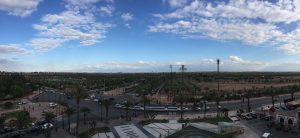
Views from the mall food court in Marrakesh
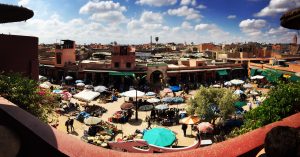
A small courtyard in the Medina, the old city markets in Marrakesh
I started working during the day again. It was hard to adjust to working during the sunshine. I was enjoying having days to explore and then nights to work, and/or sleep (which is optional during remote year).
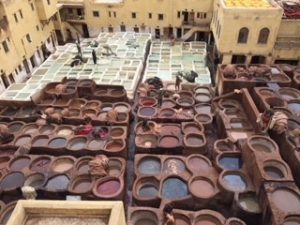 The infamous tannery where all the raw animal hides are treated, dyed, and cut for various crafts. The smell was intense.
The infamous tannery where all the raw animal hides are treated, dyed, and cut for various crafts. The smell was intense.
The landscape is reminiscent of a young, less developed southwestern United States; wild west with a mini-modern city stretched out, painted the same colors as the surrounding, scattered with a casino, an occasional tumbleweed, and a mall with a Chili’s. Baby back ribs, anyone? The old square is where most of the shopping happens. It is bursting with life! Jemaa el-fnaa, the medina or old city, is city jam-packed with trinkets, artisanal crafts, exotic foods, and spices.
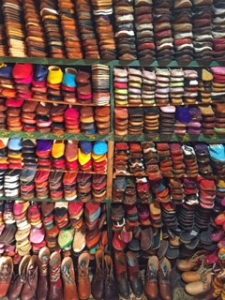
Leather Baboosh, aka Moroccan slippers are very common artisanal crafts in the Medina.
I am blown away with the languages people speak, especially in the market! Arabic, French, English, Spanish! The majority of the people were at least bilingual, often trilingual. The best salesmen spoke, what seemed like every language and could guess where you were from just by looking at you.
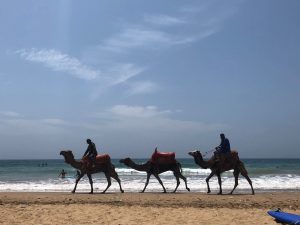 In Taghazout, camels cruising the beach were just as common as tourists. For a small fee, you can go for a quick ride and take photos.
In Taghazout, camels cruising the beach were just as common as tourists. For a small fee, you can go for a quick ride and take photos.
 Breathtaking Sahara Desert.
Breathtaking Sahara Desert.
Side trips (as we call them in Remote Year) included the surfing beaches in the north of Morocco like Taghazout and Agadir, and surfing sand dunes and camel rides in the Sahara Desert. Both adventures were incredible and reminded me that Morocco is way more than just the crazy whirlwind of Marrakesh. The natural beauty of Morocco is stunning and assisted
in opening me to the appeal of the country, but it never quite felt like home, even a temporary one.
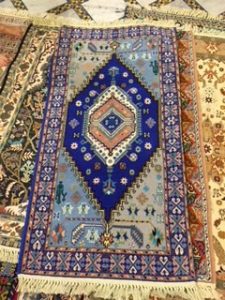 Anyone for a magic carpet ride? Artisanal rugs made with the Fez blue cobalt.
Anyone for a magic carpet ride? Artisanal rugs made with the Fez blue cobalt.
Ramadan
During Ramadan, Moroccans fast between dawn and sunset as worship to God. Because there is no separation of church and state, it is illegal for a Moroccan to eat during the day. We have a couple of people in our RY group that could have been mistaken for Moroccans; they were advised to keep their passport on them in case an issue arose when they were eating or drinking in public.
Reminiscent to the dedication during Thaipusam in Malaysia (March’s blog), I am impressed by the dedication that our local friends have for their religion. They describe Ramadan as a time to reflect, become closer to God, and abstain from eating to unify the rich and the poor. I decided to try the fasting for two days.
Day one, I brushed my teeth for 10 minutes as an excuse to try and put moisture back into my mouth. I was sure not to ingest as that would be cheating. No water, no food, all day long. What was I thinking!? A few other girls in the group were fasting in solidarity and around 8:00 P.M. we all met at my apartment to break our fast. It was like Christmas. We sat around the table and enjoyed the traditional meals for breaking the fast. Dates, Harissa (Moroccan soup), milk, and Chebakia (a honey-soaked Moroccan cookie) filled our empty bellies. I thought we were all going to stuff our faces as fast as we could, but we each took time to taste every bite. We sat around for hours and chatted, and of course, drank as much water as we could fit around all the food. Day two was much easier. I had the traditional last meal before sunrise, which I did not do the first night. I stayed awake until 3:00 A.M. just to eat and drink one last time. I had an unusual amount of energy on day two and once fast broke, I only ate a few things. Dates, more cookies, and a small piece of chicken. It was an incredible experience, both challenging myself, and being able to relate to those fasting for an entire month.
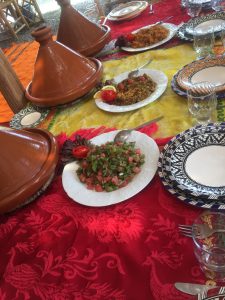 Tajine all around! Also pictured is the Moroccan salad and the beautifully crafted Moroccan dishware.
Tajine all around! Also pictured is the Moroccan salad and the beautifully crafted Moroccan dishware.
Food
In addition to the Ramadan foods, Morocco is filled with incredible flavors and diverse food selections.
Key Moroccan staples:
Tajines – a version of a Dutch oven and refers to any meats cooked over coals, low and slow.
Msemen – the BEST pancake, thin, soft, and pillow-y served with Amlou (almond butter with argon oil) and local honey.
The TEA! Mint tea, tea time is very important. It was a time to slow down and enjoy time with others. The higher you pour, the better.
Remote Year
The workspace was far away from our apartments and awkwardly quiet, I think I used it twice. I worked from home mostly as it took a lot of effort to go out as there was no Uber (this was the first location with out it), taxis seem to always want to swindle you, and I worked weird hours.
It was weird working during the day again. I found myself adjusting to work late into the evening without even meaning to. It may be that I am more productive at night, or I may have never adjusted to the local time.
 Low Atlas Mountains passing through on the way to the Sahara. Reminded me of Sedona, AZ.
Low Atlas Mountains passing through on the way to the Sahara. Reminded me of Sedona, AZ.
The final farewell to Marrakesh and our 100-day celebration (100 days of being on remote year), brought the community back together at the end of the month, which had seemed to be a little disconnected. With our sense of community revived, we set out for Croatia and a month by the sea.
Shukran & Au revoir!
Good Morning Vietnam!

I arrived in Vietnam on Saturday, March 31st! Hanoi is a busy, chaotic, energetic city exploding with eastern culture. It’s incredible, the kind of Asia I have been looking for. Until now, I have felt the previous destinations were so westernized, and have enjoyed them, but was looking for something with more shock.
Vietnam is that something more.
Everything in the city is risky. Crossing the street felt like you were swimming through a heavily populated school of fish but instead of water you are swimming through “zebra crossing,” in the concrete jungle and the fish are thousands of motor bikes that swarm around you. Stay at a steady pace and just keep walking, it may not comfortable for everyone, but once prepared, it is an energizing adrenaline rush. Eating street food is risky because of high potential for food poisoning or because of the police coming by to usher people and tiny tables off the sidewalk. If they came by in the middle of your meal, you would have to grab you table and food and pretend to move inside until they left. If you were lucky, they just did a quick drive by. In the previous cities we had Uber as a transportation option, here it is Grab Bike, a motor bike shared with a local driver. They offered a helmet so the risk of injury is slightly lessened, until they just drove on the wrong side of the road.
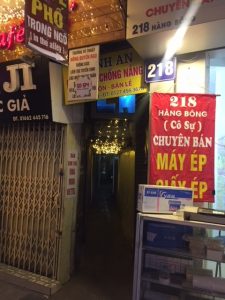
Because of the French colonization, the architecture is colonial, bursting with life down tiny alleyways, that would open to a beautiful maze of skinny, tall story homes where the ground floor served as their place of business and the floors above where the multi-generational families live. Each mini-street has a different craft, party city street, bike repair street, food street, lamp street, plastic container street, casket and flower street, small appliance street, like a Vietnamese version of Home Depot disorderly organized around the city.
The culture is a combination of everyone out for themselves and a strong sense of community. The sidewalks are where the community gathered. They were for everything but a walkway. Sidewalks were filled with live roosters, dead roosters, dogs chained up, crates filled with various small animals, millions of motor bikes both parked or driving around the obstacles, tiny baby furniture, blood, haircuts, shaves, markets, dead fish, you name it, it is happening on the sidewalk.
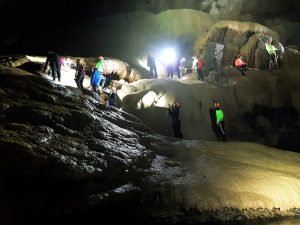
We were lucky enough to get out of the city we trekked through the wildly unexplored jungles and national parks. Jungles, trekking to the caves of Hang Va, where we learned of the Son Dong cave system that is still unmapped and mostly undiscovered. The caves we entered have been explored by less people than have summited Mount Everest.
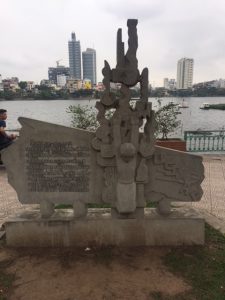
During the trek to the caves I was overcome with emotion when I thought of the young Vietnamese and American soldiers trekking through the jungle during war. The thick overgrown jungle, sharp rock formations, and muddied ground made up the path that we followed. I couldn’t imagine fighting a battle in these conditions. Respect and admiration for our Vietnam war vets filled my heart.
Inspired when I returned to the city, I went to prison. The Hao Lo Prison, known as the “Hanoi Hilton,” where we saw pictures of the pleasant time the POWs had during their stay, like a lovely Christmas celebration, or friendly basketball and volleyball games, did not seem to add up when you compared that to the emaciated figures they had when they were released. Interesting perspective. I am sure the truth is somewhere between the American version and the Vietnamese version.
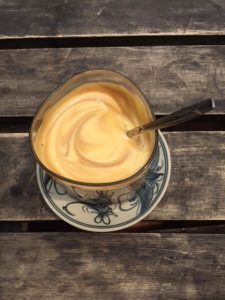
Food
On the menu:
Street food is a must, Pho, Obama’s Bun Cha vs street Bun Cha, competition between Bahn Mi 25 and 14 (personally, 25 for the win),
Hanoi Social Club and Lifted Café are a delish break from eastern foods with items like mango French toast, Social Club Burger that rivals most restaurant burgers in the US, and the happy hipster avocado toast.
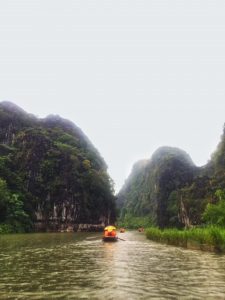
Vietnamese coffee foamed up with egg white and sweetened with sugar, appropriately named Egg Coffee, was addictively satisfying.
Our boat rower in Tam Coc is informing us of the favorite foods in the very little English he could speak, eating dog, cat, goat, pig, and sugar cane that tasted like a slightly sweet bark or a tree.
I thought dog and cat would be to… exotic for me, therefore I had to pass on the consumption.
Remote Year (month 3 away from old home with my travel family)
This month I lived three lives. One life last month of night shift work, another life was a social life with the RY Kanyinis which dipped into the night shift work life, and an independent life, thanks to the accessibility of Grab Bike (and of course, the Internet) to jump into my own adventures. Until now, I have relied heavily on the RY program and its events/planning.
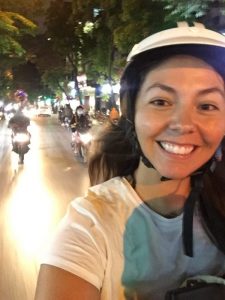
Building my experience was not lacking negative emotions. I felt a weird pressure when I was not doing enough of the touristy stuff, or exploring the same things that other remotes did, or even liking the same things as much as others did. But then, I had a candid little chat with myself, saying, “you’re not a tourist. You came on Remote Year to immerse yourself into the local cultures. To challenge yourself.” Duh, and like that, a switch flipped, I felt more open to be myself, let my guard down, became more conformable. I spent time exploring the city, hung out with people that I did not typically, and found my new normal. I am not sure if it has been because of the time on the program (like dog years, remote year time is the 1-year equivalent), my enjoyment of Vietnam, or some cosmic force, but I have felt like a citizen of the world, acclimating to this city as if it was my own.
Lived locally. Worked locally.
Now, I look forward to seeing what Africa has to offer.
Just a little unsure in Kuala Lumpur.
Goodbye Malaysia!
Month one has come to a smooth coast. Feels like the longest month of my life (in the best way possible).
Kuala Lumpur:
Wow! What a diverse population to say the least. Muslim, Hindu, Arabic, Indian, Indonesian, and Chinese influences make up the welcoming city of Kuala Lumpur, also known as KL. KL is littered with hidden labyrinths of indoor malls, amazing diverse food stalls, and pop-up restaurants. If you needed anything at all, you would find it in a mall. Need a dentist? In the mall. Need vaccinations? In the mall. Need an Auntie Ann’s pretzel fix? In the mall. Grocery stores? You guessed it, the mall.
The bustling metropolis is home to innumerable skyscrapers reminiscent of downtown Manhattan mixed with the luxurious shops of the Las Vegas Strip. The two most iconic buildings are the Petronas Twin Towers and the Kuala Lumpur Tower (pictured). Petronas has also become home to the most employees in KL, home to over 50,000 employees. Through interactions with the local people, I have learned that Maybank, Shell (oil and gas companies are abundant in the market), and Intel are large and sought-after employment options.
If there wasn’t a mall or skyscraper taking up real estate it was a temple. The temples (Hindu and Muslim mostly) in KL were stunning to say the least. The detail, dedication and decadence of the religious people is much to be admired. One of the first experiences I had was the religion procession, Thaipusam (pictured). Beautiful chaos, as we entered the Divine Circle. Religious devote faithful climbed almost 300 stairs with hooks in their flesh, bare feet, and 5 feet tall to the temples nestled inside a natural cave. As we, the remote year family, ascended the stairs, the amount of people exponentially grew as quickly as personal space diminished. At the entrance of the Batu Caves, we were greeted by devote Hindu’s eating hot coals to remove them from trance state, smells of warm bodies, incense, fragrant saffron, and turmeric permeate the air, American sports-like announcers chanting Malaysian blessings and the beat of the drums kept us going up what seemed to be a never-ending stair climb in 90% humidity. In the temple was not short of gift shops as they lined the inside of the cave, monkeys savoring bananas and other treats people were sharing, and chickens cooing and clucking in what seemed to be their form of praise. My heart and my senses were filled and the energy and passion fueled my journey for the entire month in Malaysia.
Notable observations in KL: monkeys run around the city like squirrels, our accommodations were a 5 minute walk from the world’s smallest rainforest, Bikut Nannas.
The Food:
From the moment I arrived, I knew I was going to have a strong relationship with the food here. Street food street (pictured) had anything you could desire from SE Asia. The pungent smell of durian that cuts through the air like hot steamy trash; it is more a mix of hot garbage (aka rubbish), sour garlic and a hint of pear. The local favorites were nasi lemak: a fragrant rice dish served with the most tender, slow-cooked chicken falling off the bone, covered in a sweet, spicy, and salty sauce. Eaten with your hands with creates a sensual relationship with food and those you enjoy it with. Another favorite (in which I ate far too much of) was roti with dahl. Roti is a magical tortilla style bread slathered with butter and served with, well, served with really anything as it was so versatile and delish! The tandoori chicken, unlike any tandoori chicken I have ever had. The street buffet had the best tandoori, it was charred and crisp on the outside and as you bite through the crisp outer crust of char from the open flame the internal white meat, falls off the bone and melts in your mouth. When laziness struck on the late-night work shifts we would have Uber Eats deliver some Halal, an Arabic favorite among the remote year fam.
Luckily, walking at least 5 miles a day to enjoy local events, food, or malls, helped build up an appetite without any weight gain.
The Remote Year Experience:
The walk from the accommodations to the workspace was an interesting one as you had to cross through the jungle known as bar street. The marketing tactic for the bars and restaurants was to shout at you profusely claiming they had the best drinks, food, Wi-Fi, air con (air conditioner), really anything to get to come inside. I walked down bar street nearly every day for one thing or another and thought every time, umm don’t they remember me? I walk here nearly every day. Finding a new normal did not include that walk so often I worked late nights from my apartment which was productive but could be a little lonely. Good thing I had amazing food to keep me company on those late nights.
Working night shift was an easier transition than I could even imagine. I enjoyed having my days free for exploring and had incredible support from others that had to work the same shift. It was tough as I did not see many of those who work days and could not make full use of the workspace as it would require an Uber as I did not feel safe walking home alone.
Adjusting to the culture, location, weather (mainly humidity coming from AZ where there is none), all while getting to know 34 strangers and performing the duties and functions of a full-time job. Often, we refer to time as RY time, as one mentioned is a pressure cooker. Feeling after a month of knowing our RY family, many have already become close enough to be real family. How has this only been a month? Speaking in time-space continuum, it is amazing how much you can fit into a day while working 40 hours. Sleep, optional. While I was living my best life in KL, I didn’t feel like I was doing too much, however now that I am reminiscing through the photos… I do not know how I did it all. Month one, in the books.
Quotes Of KL:
“I am not sure what I am eating, but it is delish!”
“Where is the rooftop pool? Does it have Wi-fi?” (just to get a dose of sunshine)
“What’s the Wi-Fi? (Wi-Fi is given out more freely than water.)
Insert Jurassic Park and/or Indiana Jones theme song into all adventures.
Terima Kashi! (Thank you)
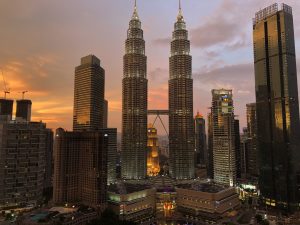


Scenario-Based Learning + Exam Readiness = Improving Employability Every Day
I’m often asked, “How do you prepare a course?” That’s a loaded question, as every course is different, but I’ll share with you a few key points as to what goes into our preparing a course for you, our beloved audience, to help improve your employability every day.
First, we are all about exam readiness. WHAT we build is centered around the exam objectives for any course we are building, plain and simple. Our main goal here is to get you ready to pass the exam and achieve whatever certification you are pursuing in any course.
What I want to talk to you about today, as your humble senior instructor, is the HOW of it all, and that is what is commonly known as scenario-based learning. Here’s a quote out of an article from Massey University: “Scenario-based learning is based on the principles of situated learning theory, which argues that learning best takes place in the context in which it is going to be used, and situated cognition, the idea that knowledge is best acquired and more fully understood when situated within its context.”
To put this in our terms, we build our course material around real-life scenarios that you can use to improve your employability prospects. Here are some examples:
- A+: You, the student, take on the role of being on-boarded at a computer repair shop, where you are taken through the A+ principles of hardware, operating systems, and troubleshooting. Within the course material, you get to practice many of these concepts while preparing for the A+ certification exams.
- Microsoft Office: We are revamping our Office offerings, and in the revamped Word course (out later this spring), you learn Word by building two main documents: a resume and a term paper. This puts you into two real-life scenarios: resume writing and managing a project (a term paper).
- Our programming track: In many of our programming courses, like HTML/CSS, JavaScript, and Java, the scenarios revolve around building code-based projects for small businesses, an absolutely critical skill for new and junior-level programmers. What better way to learn coding than by doing coding?
So, we have the WHAT, which is to cover the exam objectives, the HOW, which is to use scenario-based learning to cover these objectives, and that leads us to what Simon Sinek refers to in his famous TED talk “The Golden Circle,” our WHY, which is improving employability every day.
I leave you with one scenario-based example below, a clip from our A+ course, in which we use a scenario to cover the concept of customer service. Enjoy.

